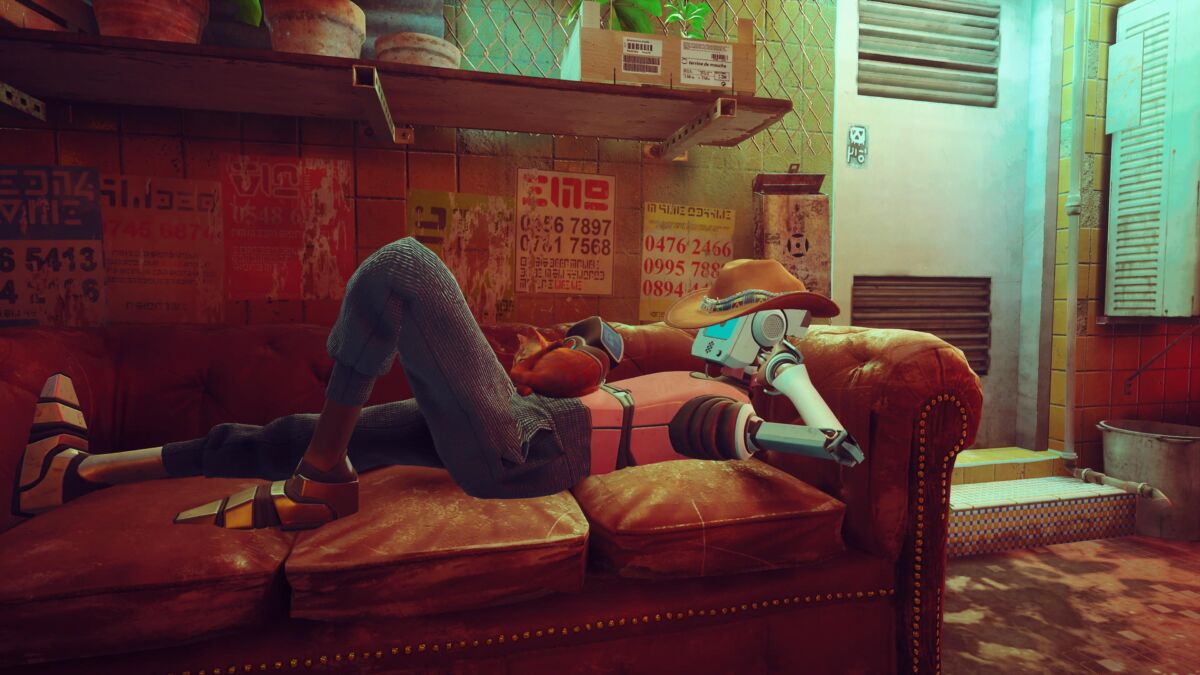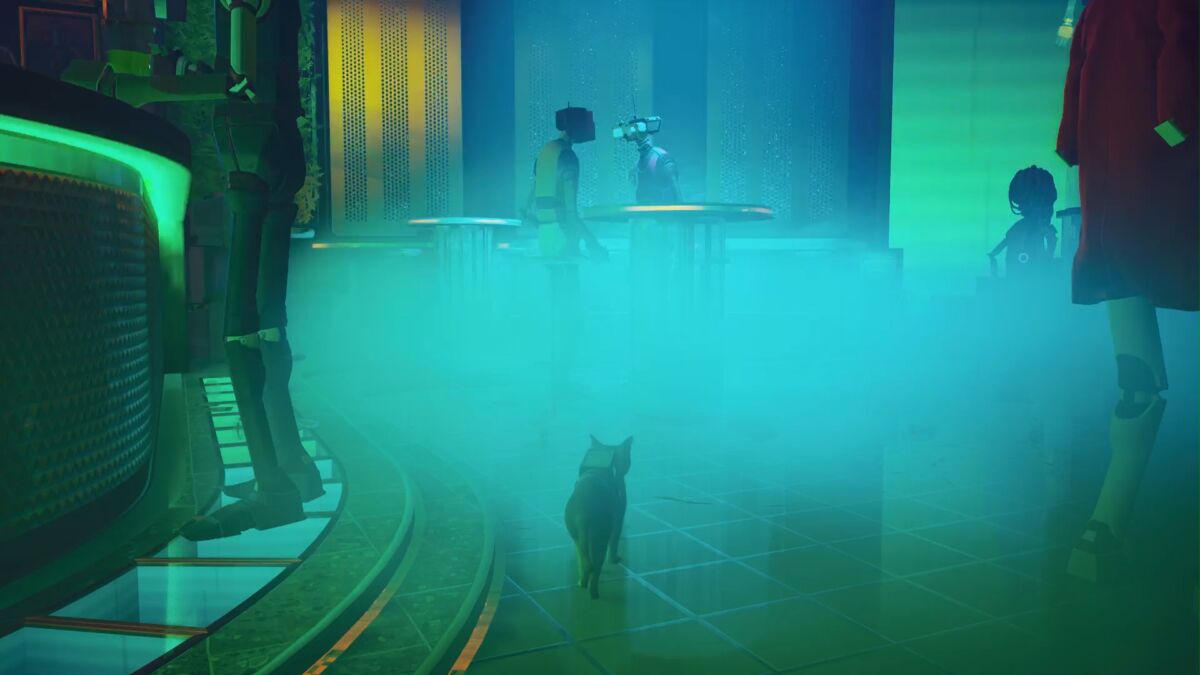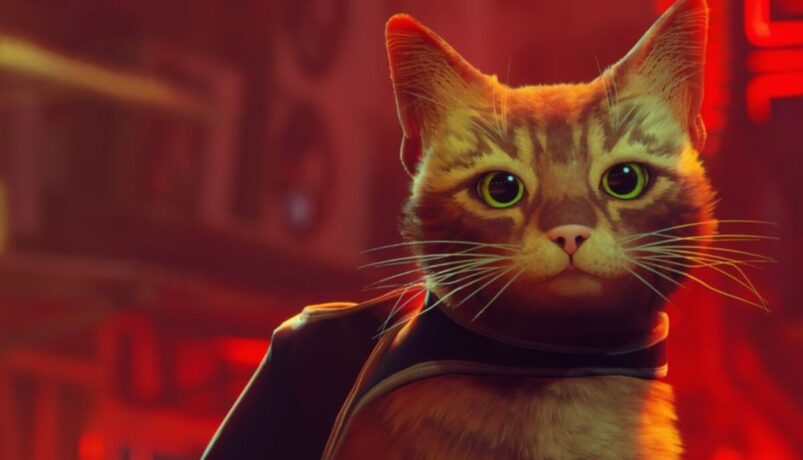It doesn’t take long for BlueTwelve Studio’s Stray to charm you, with everybody likely pinpointing the exact moment as when you first discover that you can meow on command. However, across your entire journey as a ginger cat in a strange world, Stray never really lets its standards (and the charm offensive) slip. While overall a fairly lean game, Stray feels like a welcome return to classic adventure games that were confident enough to not overload themselves with content for the sake of content.
You play as an unnamed cat (we’ll just call them “Stan”), who falls into a strange city where robots question existence and play with paint cans. Stan soon meets B12, a small drone who plans to return to the surface, an ambition that many of the robots share but are either too jaded or anxious to even try. Along with B12, you must bring the robots back together and find out some of the truths of this bizarre underground world, one catnap at a time.

It’s impossible to talk about how Stray plays without immediately calling to attention just how amazingly Blue Twelve has captured a cat in video game form. As someone who’s almost always owned a cat, Stan in Stray feels almost like you’re plugging a DualSense in to your furry friend, minus the furballs and random acts of violence. Not only does Stan move like the real thing, but there’s a huge amount of detail poured into their animations that just kept cropping up over time the longer I played. Whether it’s their ears moving in the direction of noise or idle animations that show them cleaning away or playing with flies, Stray has perfected (purr-fected?) cats in video game form. I just wish my cat would actually exercise like Stan does.
It’s all well and good to coo along as the digital cat does digital cat stuff, but how does Stray actually play? Is there more than just the unique, furry hook to keep you invested? Well, Stray feels like a game of yesteryear in the best way. There’s nothing like “cat vision” where you have to press R3 to highlight objects in the environments, and there’s no upgrade tree to help you meow louder, jump higher, or any of the RPG-lite stuff that finds its way into pretty much everything these days. You’re just a ginger cat who wants to help some robots out. Oh, and you have a cute backpack for your drone pal to sit in.

What this means is a fairly stripped-back and linear approach that focuses more on environmental interaction and character conversations than anything too intense or deep. You jump around, get your drone to translate stuff for you, occasionally nuzzle up to strangers, and also run away from strange creatures that look like they crawled out of Ravenholm. Later, you get a temporary way of dealing with these creatures, but Stray is self-assured enough to realize that it doesn’t need many gimmicks beyond being a cat in a strange world. In a way, Stray is like a more lo-fi, quadrupedal Zelda game confined mostly to a village in which Link has a much higher chance of getting zoomies.
The world itself also feels totally alive (even though it technically isn’t), with some rather gorgeous visuals to boot. The world-building, whether it’s some ancient mural or the way the robot hierarchy operates, adds layers upon layers of lore without ever bashing the player over the head with it. There’s remnants of humanity everywhere, but Stray dripfeeds in the history and lets you fill in some of your own blanks. Post-apocalyptic media is nothing new (and, honestly, perhaps a little overcooked by now), yet Stray finds a way to still make it fascinating.

The robots left behind are more than good enough stand-ins for their fleshy counterparts, though, with almost all of them being memorable for some idiosyncrasy or pop culture reference. They’re all worth your time in their own specific ways, with their early interactions with Stan being endearing due to just how bewildered and scared they are of them. From the downtrodden Slums to the more idyllic yet still industrial Midtown, the citizens of Stray are all fascinating and do more to fill in the game’s world than a discarded textbook left for the player to find ever could.
While altogether a short game clocking in at around 5 or so hours, Stray does have lots more to uncover beyond the rolling of the credits. There’s badges to adorn Stan with for completing some side quests, trophies to unlock, and even speedruns to complete like you’re trying to escape Raccoon City. Stray is the classic “weekend” game of old, something that you can complete in a few sittings that doesn’t require an absolute tonne of concentration or wiki-delving. Some may find it a bit short and while it’s fair to argue that the ending feels a tad abrupt, for people who don’t want to be tied to one game for a long amount of time and remember when linearity wasn’t almost a dirty word in gaming, Stray is a refreshing adventure that tells a compelling tail.
A PS5 key was provided by PR for the purposes of this coverage.
Stray is available on PC, PS5, and PS4.
READ NEXT: Is Stray Coming To Xbox?
Some of the coverage you find on Cultured Vultures contains affiliate links, which provide us with small commissions based on purchases made from visiting our site.

